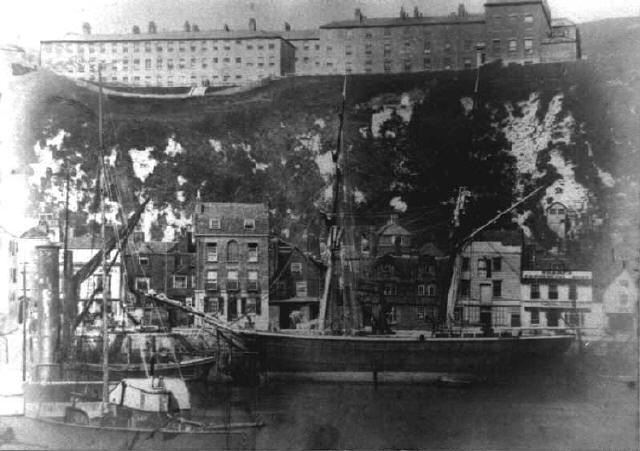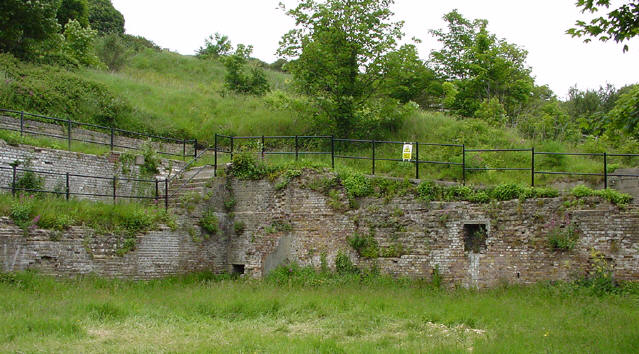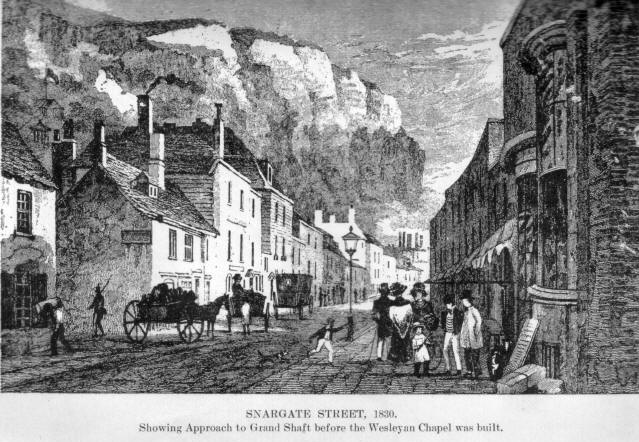|
"The modern adaptation of the Western Heights for Military purposes
commenced during the American War. Previous to that time the
inhabitants of Dover, foot and fancy free, were able to roam at will
over these breezy hills, on which there was no object to break the
rural character of except the 'Devil's drop of mortar,' for the
Knights Templars' house had by that time been destroyed, and the
foundations of the Church had not been uncovered. The first
Military works on this hill were but trenches and isolated
blockhouses, with a miscellaneous collection of 72 heavy guns planted
along the ridge commanding the approach from the sea. These
works did not bar the public from rambling over the Western Heights,
and when Peace was made with America, these guns were left amidst the
herbage, with flocks of sheep around them, forming a curious pastoral
picture."
(J.B.J. 1907)
|
|
This photograph, taken towards the end of the 19th
century, shows vessels moored alongside the Commercial Quay. On
the right can be seen Sharp's Commercial Quay Inn.
The buildings on the face of the cliff (see above roof of inn) are at
the top of the gardens of properties in Snargate Street. Some of
these gardens are still maintained by their present owners, although
almost vertical and on solid chalk!
The buildings on the top of the cliff are the former Grand Shaft
Barracks, part of the Western Heights fortifications, built during the
Napoleonic Wars.
|
|
The Grand Shaft, a triple, spiral staircase in a brick shaft, connected
the barracks to Snargate Street to provide rapid access to the harbour in
case of invasion. The idea of the triple staircase was thought to
have been to provide separate access for "Officers and their ladies",
"NCOs and their wives", and "Other Ranks and their women"!
"The Grand Military Shaft, an arched passage with steps, leading
from the lower part of Snargate Street up to the Western Heights, was
one of the conceptions of Sir Thomas Hyde Page, military engineer, the
construction of which was commenced in 1779, but not completed until
1802. The long arched passage, leading from the guard-house near
the Wesleyan chapel, terminates at the bottom of a perpendicular shaft,
up which there is a three-fold spiral flight of 140 steps, one section
of the way up being for officers and ladies, one for 'women,' and one
for soldiers. From the top of the spiral flight there are 59 more
steps, leading up into the barrack yard. These steps are included
amongst the rare features of Dover by excursionists, and, when they were
first constructed, were so regarded by the townspeople and soldiers,
bets being often made as to how quickly they could be climbed. Mr.
Leath, of Walmer, for a wager, rode his horse up these steps, in the
year 1812. A sentry is always mounted at the Snargate Street
entrance of the Shaft, and a guard ready to be turned out in the
adjoining guardroom. This guard has been a familiar feature of
this part of the street since the militant days of Napoleon Bonaparte."
(J.B.J. 1907)
It has
recently been restored and opened to the public. A new gate
and guardroom have been built to replace the original which was demolished
some years ago in the redevelopment of Snargate Street. The Barracks
have, however, been demolished.
|






